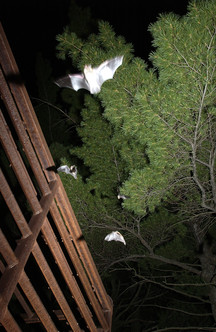Wildlife Conservation Month would not be complete without bats!
Significant effort has been put in over the years to conserve Michigan's bats, and we would be remiss not to celebrate that work during Wildlife Conservation Month.
You might not think bats need our help, particularly if you see a lot of them around on warm summer nights; however, many bat species are in decline nearly everywhere they are found, including in Michigan.
White-nose syndrome is a major culprit in this decline. This deadly disease affects bats in Michigan and throughout North America. Infected bats prematurely awaken from hibernation, rapidly deplete their fat reserves and are unable to survive the winter. Bats with white-nose syndrome often exhibit unusual behavior, such as flying during daylight hours or gathering outside of caves in cold weather.

The Michigan Department of Natural Resources has been working with several researchers on different methods to try and mitigate the impacts of white-nose syndrome and has made efforts to protect many hibernacula (where bats spend the winter) throughout the state.
One example, to minimize human disturbance to hibernating bats, is gating entrances to important bat hibernacula. Custom steel structures are designed and put in place to ensure public safety while allowing the bats to freely come and go from the hibernacula.
“Some of these gated sites are important locations to protect because they house large populations of bats in the winter,” said John DePue, wildlife biologist with the DNR.
|

Michigan is also one of only a few states that participates in field trials of potential treatments to combat white-nose syndrome.
Working with the DNR, researchers and students from Western Michigan and Ball State universities have been applying an organic compound – derived from shellfish, called chitosan – to bats and the inside of hibernacula. This chitosan compound appears to help bats combat the effects of white-nose syndrome.
|
Researchers from University of California, Santa Cruz have been treating some of Michigan's hibernacula with chlorine dioxide. The treatment is applied to the site when bats are not present to reduce the number of spores that cause white-nose syndrome.
DePue said that chlorine dioxide is used to disinfect the site by killing the fungal spores during the summer, before bats return for the winter in order to reduce infection and mortality rates.
“We’ve also noticed, through annual hibernacula site monitoring over the years, that sites with cooler temperatures have lower mortality rates from white-nose syndrome,” said DePue. “This is likely because the growth of the fungus may be suppressed at these lower temperatures.”

In partnership with Michigan Tech University’s Geological and Mining Engineering staff and students, MTU forestry and wildlife students, as well as Bat Conservation International, efforts are underway to use mining ventilation techniques to reduce the temperature at the Carp Lake Mine hibernacula site by a few degrees to see if it will have an impact on bat survival rates.
|
In another partnership, DNR staff members have been working with a team of researchers from Virginia Tech to study bat microhabitat use. In other words, researchers are looking at smaller, more specific areas within a larger habitat, such as portion of a cave or mine, that the bats are using and noting which features of that microhabitat differ from the larger habitat around it. Information from this research will help inform future bat management decisions.

Annual bat monitoring is also conducted by DNR staff and researchers from Eastern Michigan University. Hibernation sites are visited during the winter to learn about places where bats are experiencing higher survival rates, and to monitor population trends.
|
You too can give bats a helping hand by conserving bat habitat, putting up a bat house, complying with mine closures and following decontamination guidelines to reduce the spread of white-nose syndrome. Learn more at Michigan.gov/Bats.
Please remember, bats, like all wild animals, should be treated with respect and left alone. For your safety, if you find a bat outside, leave it alone. In situations where a bat has been in close contact with people, if possible, safely confine the bat and contact your local health department to determine if it should be tested for rabies. Learn more at Michigan.gov/Rabies.
Questions? Contact the DNR Wildlife Division, 517-284-9453
|